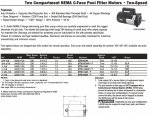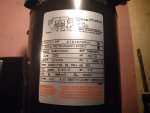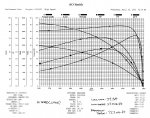My wife got me a two speed replacement motor for our superpump as a birthday gift ïŠ I gave her a direct link to a web site and it was a link for STS1072R motor. However the one that we received was STS1072RV1, which is slightly different model but still a direct replacement for my pump.
I tried to research the differences but couldn’t find a lot of info and what I found is somewhat confusing. Attached is an excerpt from AOSmith pdf.
So maybe someone with good knowledge can help me understand couple of things:
1. R motor has nameplate HP of 3/4-1/8 for Hi/Lo and RV1 version has 3/4-1/10 for Hi/Lo (SF is omitted for simplicity since it’s the same for both models). So it looks like it will deliver less power for low speed, which I’m happy about, but then looking at full AMPs it’s 6.4/1.9 for first motor and 5.4/2.2 for second one! I would think that the AMPs for lower speed for second model would be lower than for the first one since it seems to be more energy efficient model to begin with and lower speed has even less power. But the AMPs are higher!
2. The RV1 model has a big capacitor on the body of the motor (pictured). I know there is a start capacitor under end cap for both models, but I’m not sure what is the purpose of this other one. The PDF says “Energy Efficient capacitor start, capacitor run “Conservationist†motor†so maybe the capacitor is for the “conservationist†mode, but I don’t really know what that means.
So overall it seems that RV1 is newer more energy efficient motor that is replacing the older R model and I should be happy that I got better motor than that I paid for. However I still don’t understand the 2.2 AMPs on low speed – that doesn’t seem to make sense.
I’d appreciate if someone can shed some light on this for me.
I tried to research the differences but couldn’t find a lot of info and what I found is somewhat confusing. Attached is an excerpt from AOSmith pdf.
So maybe someone with good knowledge can help me understand couple of things:
1. R motor has nameplate HP of 3/4-1/8 for Hi/Lo and RV1 version has 3/4-1/10 for Hi/Lo (SF is omitted for simplicity since it’s the same for both models). So it looks like it will deliver less power for low speed, which I’m happy about, but then looking at full AMPs it’s 6.4/1.9 for first motor and 5.4/2.2 for second one! I would think that the AMPs for lower speed for second model would be lower than for the first one since it seems to be more energy efficient model to begin with and lower speed has even less power. But the AMPs are higher!
2. The RV1 model has a big capacitor on the body of the motor (pictured). I know there is a start capacitor under end cap for both models, but I’m not sure what is the purpose of this other one. The PDF says “Energy Efficient capacitor start, capacitor run “Conservationist†motor†so maybe the capacitor is for the “conservationist†mode, but I don’t really know what that means.
So overall it seems that RV1 is newer more energy efficient motor that is replacing the older R model and I should be happy that I got better motor than that I paid for. However I still don’t understand the 2.2 AMPs on low speed – that doesn’t seem to make sense.
I’d appreciate if someone can shed some light on this for me.




